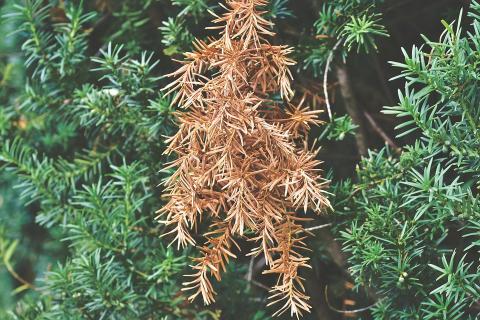Why are my evergreens shedding yellow and brown needles?

Though some plants are termed “evergreen”, that doesn’t mean they never lose their needles. Evergreens go through a natural cycle of dropping and replacing old foliage just as deciduous plants do. They just do it on a slightly different schedule. While a maple tree will only keep its leaves for a single growing season, a pine tree may hold onto its needles for two seasons. Eventually, needles become old and worn and drop from the tree naturally. The oldest needles are those that are closest to the trunk along a branch. These are the needles you should expect to turn yellow or brown and drop from trees and shrubs in the fall. Pines, hemlocks, spruces, and arborvitae shed some needles in the fall every year and produce new needles the following spring.
If trees are dropping needles from the inside (toward the trunk), then it is probably normal shedding. However, if the tree is losing its outer needles while the inner needles are still green, there may be something else going on. Environmental stressors such as too much water, drought, or herbicide exposure can cause needles to brown and drop. Damage from various insects and diseases can also cause foliar symptoms during the growing season. Assume one of these living factors is to blame if the damage seems random or spotty, and take advantage of the UNH Plant Diagnostic Lab for disease identification and management recommendations.
Once an evergreen branch has turned completely brown, there is little to no chance for recovery. Most evergreen trees, like pines, hemlocks, and spruces, only produce new growth at the tips of their branches. Once these growing points are damaged or killed, the branch will only continue to deteriorate. Dead branches can be pruned out at any time. A few evergreen species, such as arborvitae and Chamaecyparis, can produce new growth from latent buds along their stems as long as you don’t prune into the “dead zone” (the area beyond where green needles are growing).
Evergreens can be resilient and low maintenance as long as they are planted in the right location and given proper care until they become established. Whenever possible, try to plant new evergreen trees and shrubs in protected locations out of prevailing winter winds. Marginally hardy species may even benefit from some extra winter protection in the form of burlap wind barriers or wrappings. Additionally, it is essential to irrigate recent plantings until the ground freezes to help root systems recover from stress. Even mature trees and shrubs can benefit from receiving an inch of water per week in the fall, especially during prolonged periods of drought.
Got questions? The Ask UNH Extension Infoline offers practical help finding answers for your home, yard, and garden questions. Call toll free at 1-877-398-4769, Monday to Friday, 9 a.m. to 2 p.m., or e-mail us at answers@unh.edu.
Related Resource(s)
Do you love learning about stuff like this?
SUBSCRIBE TO Granite State Gardening newsletter
Got questions? The UNH Extension Yard and Garden Infoline offers practical help finding answers for your yard and garden questions.
Call toll free at 1-877-398-4769, Monday to Friday, 9 a.m. to 2 p.m., or fill out webform.
